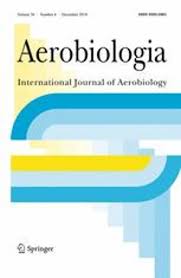Ver ítem
- xmlui.general.dspace_homeCentros Regionales y EEAsCentro Regional MisionesEEA MontecarloArtículos científicosxmlui.ArtifactBrowser.ItemViewer.trail
- Inicio
- Centros Regionales y EEAs
- Centro Regional Misiones
- EEA Montecarlo
- Artículos científicos
- Ver ítem
Daily, seasonal, and interannual variability of airborne pollen of Araucaria angustifolia growing in the subtropical area of Argentina
Resumen
Araucaria angustifolia is an anemophilous conifer native to Southern America threatened with extinction, with a noticeable decrease in its distribution area and seed production. To better understand the reproductive dynamics, the aerobiological curves obtained with Hirst methodology were analyzed during 7 years in San Antonio (Misiones, Argentina), including productivity, seasonality, start, end, duration, and peak, along with the role of
[ver mas...]
Araucaria angustifolia is an anemophilous conifer native to Southern America threatened with extinction, with a noticeable decrease in its distribution area and seed production. To better understand the reproductive dynamics, the aerobiological curves obtained with Hirst methodology were analyzed during 7 years in San Antonio (Misiones, Argentina), including productivity, seasonality, start, end, duration, and peak, along with the role of meteorological/seasonal climate factors. An alternation between 1 year of high pollen values (1685 pollen grains day m-3, on average), followed by 2 years of a progressive reduction (456 pollen grains day m-3, on average) in productivity, was observed. This pattern was negatively related to temperature during the month preceding pollination; August minimum temperature yielded the best fit (correlation coefficient r = - 0.9, p\0.01). In only 36 days, including October, 90% of the annual pollen was released. The daily pattern showed a curve with higher concentrations between hour 8 and hour 14. The daily maximum at hour 10 suggests pollen inputs from local sources. The eolic transport is limited due to the big size and weight of the grains and the unfavorable atmospheric conditions that prevail in this subtropical forest (high humidity and low wind speed). The average airborne
pollen curve showed a peak during the second fortnight of October. Rain induced a noticeable reduction in pollen concentration modifying the shape of the aerobiological curve. Aerobiological analyses provide reliable information for the design of conservation
strategies, such as ex situ planting and selective harvesting of seeds.
[Cerrar]

Autor
Latorre, Fabiana;
Rotundo, Cristian Andres;
Abud Sierra, María Laura;
Fassola, Hugo Enrique;
Fuente
Aerobiologia 1-14 (publshed online: February 2020)
Fecha
2020-02
Editorial
Springer
ISSN
0393-5965
1573-3025
1573-3025
Formato
pdf
Tipo de documento
artículo
Palabras Claves
Derechos de acceso
Restringido
 Excepto donde se diga explicitamente, este item se publica bajo la siguiente descripción: Creative Commons Attribution-NonCommercial-ShareAlike 2.5 Unported (CC BY-NC-SA 2.5)
Excepto donde se diga explicitamente, este item se publica bajo la siguiente descripción: Creative Commons Attribution-NonCommercial-ShareAlike 2.5 Unported (CC BY-NC-SA 2.5)

